How to Bleed a Radiator? Easy DIY Step By Step Guide
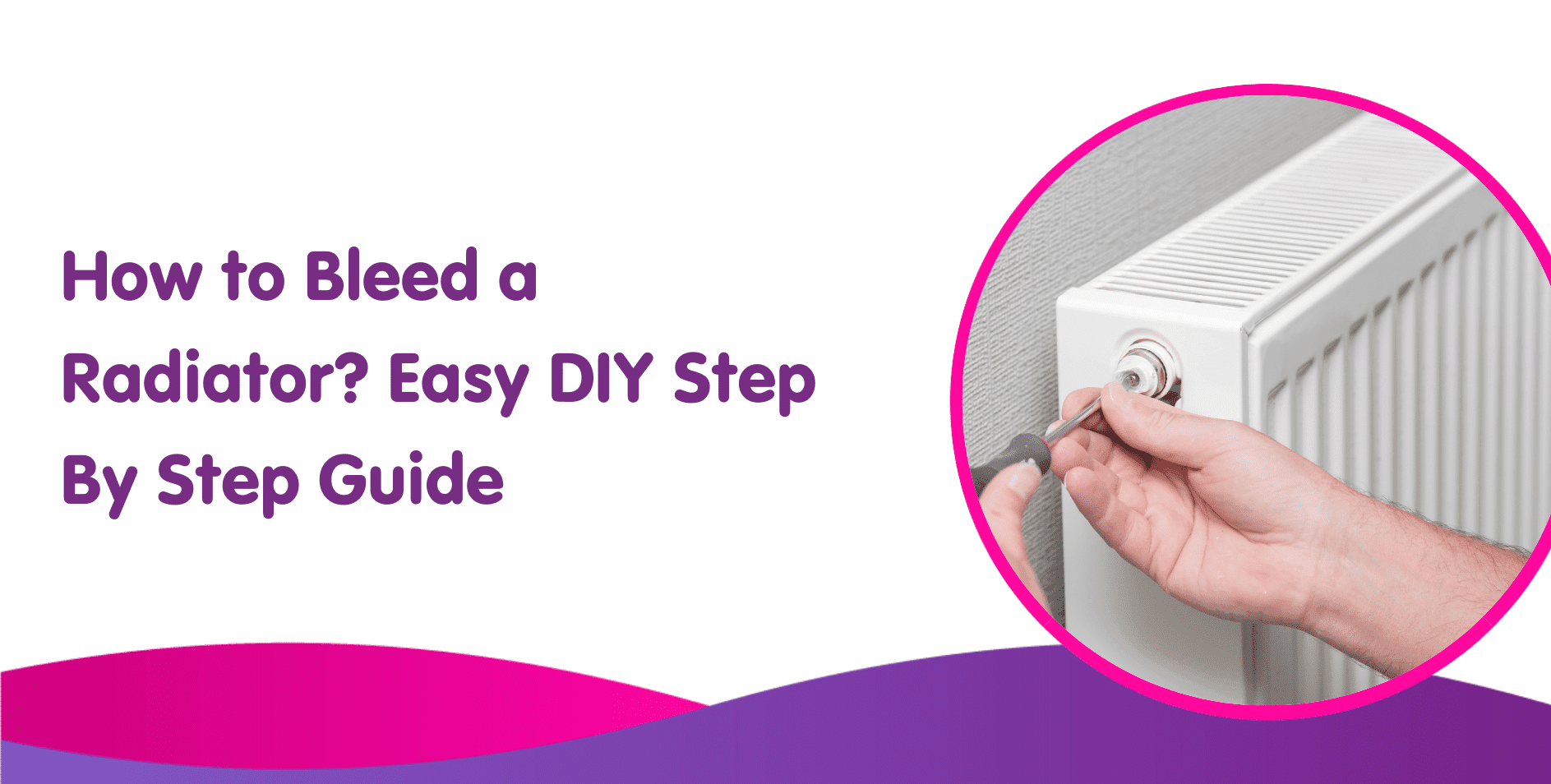
Jump to:
- Bleeding a Radiator DIY Easy Step by Step Guide For Energy Efficient Central Heating
- Why is it necessary to bleed a radiator?
- What does bleeding a radiator mean?
- How do I know if my radiator needs bleeding?
- How often should you bleed your radiators?
- What Do I Need to Bleed my Radiator?
- How to bleed a radiator
- Bleeding a Radiator FAQs
Bleeding a Radiator DIY Easy Step by Step Guide
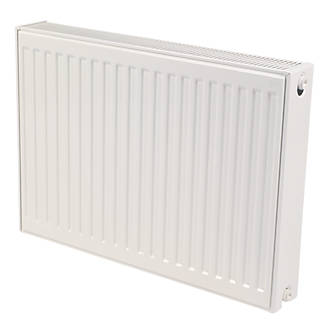
So you want to bleed a radiator because there’s nothing more disheartening than waking up on a freezing day to radiators that refuse to warm up.
If your heating is on, but your radiators stay miserably cold to the touch (especially at the top) you may need to bleed your radiators.
Get a new boiler quote in under 20 seconds by clicking get a fixed price now
Get an online fixed price in 20 seconds:
It is particularly important to bleed your radiators (release air trapped inside them so that heat can circulate properly) because inefficient heating is a massive money drain.
If your radiators aren’t working properly, you’re more likely to dial up your thermostat and waste your hard-earned money trying to get warm.
The good news is: that you don’t need to pay a professional to bleed a radiator. It is a fairly simple procedure that you can do yourself, with just a couple of tools.
In this step-by-step guide, we’ll cover exactly how to bleed a radiator. We’ll go through the equipment you need, how to tell which of your radiators needs bleeding, and how to check your radiators are working properly after you’ve bled them.
Video: How to Bleed Your Radiators – Quick and easy guide to bleeding radiators
Find out how to bleed your radiators quickly, easily, and safely with our guide to bleeding radiators.Get an online fixed price in 20 seconds:
Why is it necessary to bleed a radiator?
When there is trapped air inside of a radiator, it has to be bled to release it. Often known as an airlock, the heated water in your radiator is unable to circulate because of the trapped air. As a result, the radiators are not heating up or may be warm at the bottom and cold at the top.
It indicates that your central heating system isn’t operating well and that your room may take longer to warm up. As a result of your increased expenses, it might also be costly.
If you have noisy radiators that are banging, clanging, or gurgling, you may also need to release the trapped air as an airlock can cause more issues in the long run.
Even if your radiators are in good condition, it is advised that you bleed them once a year.
What does bleeding a radiator mean?
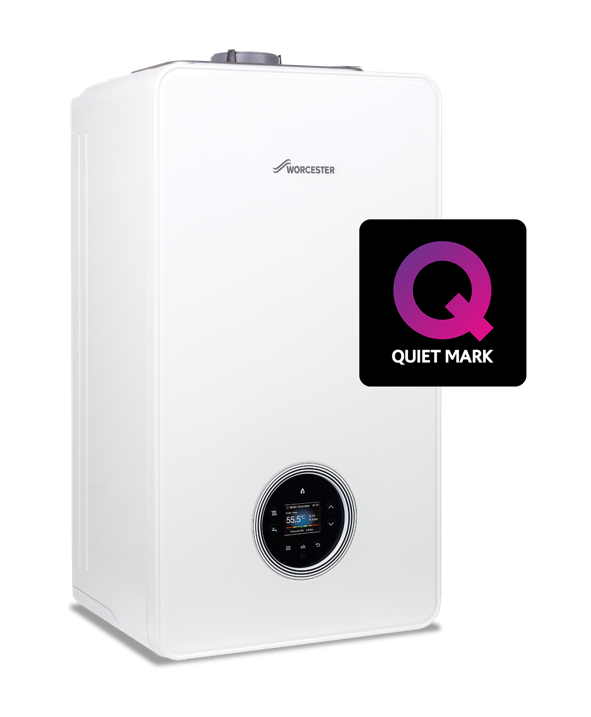
Bleeding a radiator means releasing air that has built up inside the radiator and is currently stopping it from getting warm. If you have an old central heating system, you may need a new replacement boiler, but check if this helps first.
Bleeding is different from draining a central heating system, which empties the water out, not just the air in the pipes.
The procedure of “bleeding a radiator” involves getting rid of any extra or trapped air in the system. Since air cannot be heated in the same manner that water can, this is typically the cause of a radiator’s top feeling chilly.
Only approximately halfway up the radiator can the hot water reach due to air rising and being caught. This is incredibly inefficient and may help to explain why you’ve been seeing cold patches or draughts in your house, or just wondering why a room seems a bit cool.
When you flush a system, you remove the water; when you bleed your radiators, all you do is let the air out.
It’s a quick procedure that might increase the effectiveness of your heating system.
This means you’re paying full price for heating, but not getting the right amount of warmth in return. Your heating system will also use more energy to compensate, which leads to even higher heating bills.
How do I know if my radiator needs bleeding?
Your radiator probably needs bleeding if:
- Your boiler is turned on, but the radiator only feels warm at the bottom near the pipes and gets steadily colder towards the top. This suggests that air has risen to the top of the radiator and prevented the hot water from moving through. If your radiator has a huge amount of trapped air, it may feel cold all the way through.
- Your boiler pressure is too high. Too much air trapped inside your heating system can push your boiler’s pressure above the normal range of 1.0 to 1.5. To reduce boiler pressure and bring it back to a normal reading, you’ll need to bleed your radiator. If this doesn’t work you may need a replacement boiler
- Your radiator makes funny noises. Burbling, gurgling and rattling noises from within your radiator all suggest that it needs bleeding.
Get an online fixed price in 20 seconds:
How often should you bleed your radiators?
You should do a routine check on your radiators once a year, to see if they need bleeding.
We advise turning on your heating to check whether your radiators have any cold spots, in advance of the winter months. This way, you can find out which radiators you need to bleed and ensure that your heating is in perfect working order for when the cold sets in.
It usually only takes between 20 and 30 seconds to bleed a radiator, although it can take longer if the radiator is particularly large or if there is a lot of air trapped inside.
If you have removed your old radiator and replaced it, it is always good to bleed the system at the end too.
What Do I Need to Bleed my Radiator?
A radiator bleed key
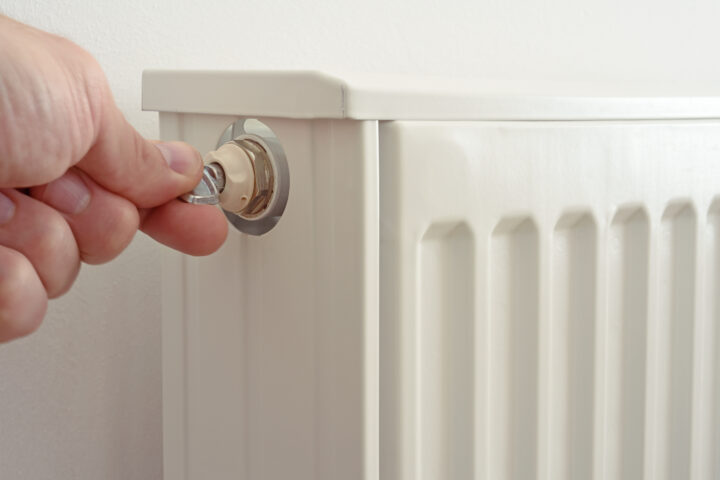
Most modern radiators (produced in the last 30 years) will have the same type of bleed valve that will fit a standard radiator key.
However, if you have an older radiator produced according to the imperial rather than metric system (inches rather than centimetres), it may have a bleed screw head that fits a clock key. Usually, you’ll need a clock key between sizes 8 and 12 to release your bleed valve.
You can buy radiator bleed keys on their own or as part of a key that has multiple attachments, including spanners to replace radiator plugs and valve tails. Just be sure to check, if you’re buying a ‘universal key’ for your radiator, that it actually includes a bleed key, as some multi-purpose keys don’t have this function.
If you don’t have a radiator bleed key
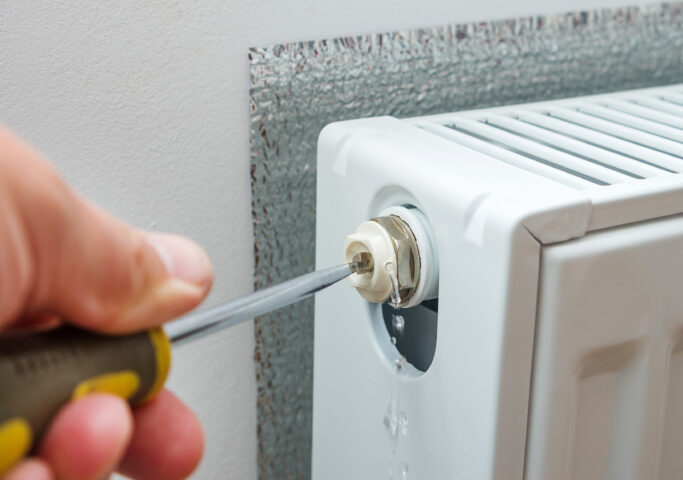
It’s always a good idea to use an actual radiator bleed key to bleed your radiators, as this reduces the chance of damage to the valve (and a potentially costly repair or replacement).
However, for modern radiators with standard slotted screws in their bleed valves, a flat-headed screwdriver will do the job just as well if you don’t have a key. If your radiator is of the older variety or features a different kind of bleed screw, for example, a hexagonal or square knob, you can try an Allen key or radiator spanner.
Never use pliers to try and grip and turn your bleed valve! While you might succeed in opening the valve, you risk breaking and damaging it.
A rag
Make sure you have a simple cloth rag to hand when you’re bleeding your radiator. This is because as soon as you have bled the air out of your radiator, the water that now has room to rise will start dripping out, and you’ll need something to catch it. The rag can also help create enough friction to turn the bleed valve if it’s particularly tight.
Old towels and dust sheets
Bleeding radiators will inevitably cause some water spillage, so it’s a good idea to lay down towels or dust sheets to protect your floors from damage, especially if you have lovely, pale carpets.
If you have older radiators the water inside them may have reacted with rust and dirt, and become discoloured over the years. This is even more reason to use towels to shield your floors from water damage.
Get an online fixed price in 20 seconds:
How to bleed a radiator
To bleed a radiator, you need to first identify that it is a hot water radiator (rather than a steam-based one), turn off your central heating to avoid scalding, lay down towels to protect against water damage, and use a bleed key to open the bleed valve in your radiator, to release the trapped air inside.
After you’ve bled all the radiators in your home, you’ll need to check the water pressure on your boiler, and re-pressurise if it has dropped too low. You’ll then need to turn your heating system back on again, to check that the procedure has worked and your radiators are now warming up properly.
9 steps to bleed a radiator
Here is our quick guide to how to bleed a radiator, safely, easily, and cleanly. If this process doesn’t work, you may have more issues with your boiler. If so, check out how much a new boiler costs now online in seconds using our online boiler calculator tool. You can even get a new boiler on finance too if you want to spread the cost.
Check what type of radiator you have
Before you start the bleeding process, make sure that your radiator is part of a hot water heating system, rather than a steam one.
If you have steam radiators, they don’t require bleeding (nor would this be effective). If your radiator has a single pipe running into it and a (usually bullet-shaped) air vent sticking out of the side, it is likely steam-based. A hot water radiator usually has two pipes coming into it, and if you’ve identified that your heating system is water-based, you can skip this step and jump to the next one.
Cleaning your steam radiator air vent
If your steam radiator isn’t warming up properly, cleaning the air vent can help the heat to circulate properly. The vents on steam radiators are designed to allow air to escape naturally, but these can get clogged with dirt and particles and – similarly to hot water radiators – stop the radiator from heating up.
To clean your steam radiator air vent, first, make sure your heating is turned off. Then, use a wrench to carefully remove the air vent from the radiator (make a counter-clockwise turn).
Heat up some vinegar (standard white vinegar from the supermarket is absolutely fine) and submerge the air vent in it for 30 minutes. This should remove rust and anything else blocking the vent. Next, rinse the air vent and blow through it. If air moves freely through the vent, you can reattach it to your radiator. If not, repeat the cleaning process.
Air vents on steam radiators often get accidentally painted over, which can clog them up and stop them from working properly. If this has happened, take a needle or strong piece of wire to poke through the obstruction and free the vent’s air holes.
Turn on your central heating
Before anything, you need to find out which radiators in your home need bleeding, as it’s important not to perform the procedure on a radiator that doesn’t need it.
If you try and bleed a radiator that doesn’t have any trapped air to release, water will spill from it as soon as you open the bleed valve. This can rapidly lower your boiler’s water pressure, and your whole system could fail.
Once you’ve turned on your central heating, go around your property and check if any radiators aren’t warming up properly. Remember that if radiators have cold spots or are warm at the bottom but cold at the top, they likely have air blockages. It’s a good idea to wear a pair of light gloves as you check your radiators, to avoid burning yourself on hot radiators.
Don’t forget to check for rattling and gurgling sounds from your radiators, as these are also signs that they need bleeding.
Make a careful note of the radiators which need bleeding during this check. A good tip is to put post-it notes or stickers on the malfunctioning radiators, so you can be absolutely sure which ones to start on.
Turn off your central heating
Once you’ve identified which of your radiators need bleeding, make sure you turn your central heating off. Bleeding your radiators with the heating on could seriously injure you, as scalding hot water is likely to burst out of the bleed valve as soon as the air has come out.
When all your radiators are entirely cold to the touch, you can get started on bleeding your radiators.
Lay down towels to protect against water escaping
It’s impossible to avoid water spillage when you bleed your radiators, no matter how quickly you close the bleed valve after you’ve let the air escape.
You need to let at least some water drip out from your radiator so that you can tell when the trapped air has fully escaped. As a result, we suggest putting down towels and dust sheets to protect the floor around your radiators and avoid water damaging your floors or carpet.
You can also use a container to catch any water spills when you’re bleeding your radiator.
Use your bleed key to open the radiator bleed valve
Take your radiator key (or flat-headed screwdriver if you don’t have a radiator key to hand), and attach the end of the key to the square slit in the centre of the valve.
When you insert the key into the groove, you’ll feel them click together. Remember that if you have an older radiator, the bleed valve may look different, and you’ll need a clock radiator key to open it.
Bleed your radiator
Turn the key in an anti-clockwise direction (use a rag to help grip the key, if the bleed valve is particularly tight). You should hear a hissing noise, which is the trapped air at the top of the radiator starting to escape.
The release of the air from your radiator means that the water in your system now has room to rise. This will happen fairly quickly after you’ve bled out the air, so get your rag ready to catch the drops. Never turn the valve more than a half-turn when you’re opening it and be ready to close it quickly. Modern radiators can release water as a jet and you want to avoid as much spillage and low water pressure as possible.
Repeat on all radiators
Once you’ve finished bleeding the radiator, you can go and repeat the procedure on all the other radiators in your home that require bleeding.
You should start with the radiator that is furthest away from your boiler. If your property has two stories, start with the most distant radiator on the ground floor, and work your way up to the top of the house, ending with the radiator closest to the boiler.
Check the pressure on your boiler
Bleeding your radiators always involves some loss of water, and this can cause the pressure in your heating system to drop.
Make sure you check your boiler pressure as soon as you finish bleeding the radiators, because if your boiler pressure falls below a safe level, your heating system will become inefficient and use a lot of energy trying to heat your house, driving up your heating bills (the very thing you were trying to avoid by bleeding your radiators!).
To check your boiler’s pressure, look for the water pressure gauge which is usually located on the front of your boiler. If you have a hydraulic gauge (a gauge which displays pressure using a dial), the indicator needle will fall below 1 if there’s not enough water pressure. If you have a digital gauge, you should see a flashing reading if the water pressure is too high or low.
How to repressurise your boiler
You might need to repressurize your boiler if the pressure is too low. Even though you can complete this task on your own, we do advise calling a heating engineer if you have any doubts or believe you’ll find it difficult to complete it on your own.
Depending on the type of boiler you have, you may have either an external filling hose (or ‘loop’) or an internal filling key to top up your boiler. While we give you a general overview of how to repressurise a boiler using the internal and external methods, make sure you check with your particular boiler manufacturer to find the correct repressurising method for your specific boiler.
Repressurising your boiler with an external filling hose
- Locate your external filling hose. It is usually close to the boiler, but it can sometimes sit under the kitchen sink or in the airing cupboard.
- Ensure that your boiler is switched off
- Securely attach both ends of the filling hose to your boiler valves (some boilers will just have one valve).
- Open both valves to allow water to fill from the mains system into the heating system. You should be able to hear water coming into the boiler.
- Fill your system until your water pressure shows a normal reading again (1.5).
- Close the first valve and then the second one if you have two.
- Release your hose and disconnect it.
Repressurising your boiler with an internal filling key
- Ensure your boiler is switched off
- Insert your filling key into its correct slot.
- Turn the key. How you do this depends on the boiler you have. For example, if you have a Worcester boiler, the slot will have an open and closed padlock sign on it. Your key will have an arrow marked on it, and you’ll need to align the key with the open padlock sign. You then turn the key to the closed padlock sign.
- Turn the knob beside the key counterclockwise, and you should hear the water start to fill the system. Wait for your gauge to show a normal reading again (1.5).
- Turn the key to the open padlock sign, and remove it.
Turn your heating back on to check your radiators
Now that you’ve completed the radiator bleeding process, you’re ready to turn your heating back on. Check your radiators to see if they are now heating up all the way through. If this doesn’t work, you may need to contact a heating engineer.
So, there you have it. 9 simple steps to bleed a radiator. We hope you’ve found this a useful read, and now have the confidence to tackle those lukewarm radiators, and get them piping hot for winter.
If you have an old central heating system and boiler, it may be time to consider upgrading. Here at Boiler Central, we have all the latest new boilers from all the best brands, so why not get a quote now?
How To Bleed a Radiator Summary
- A trapped air pocket may result in chilly areas.
- You may get rid of the air by bleeding your radiators.
- Using a radiator bleed key, you may bleed each radiator one at a time.
- To maximise the effectiveness of your heating system, perform this task at least once a year.
- It could be necessary to top off your boiler pressure if you bleed your radiator.
Bleeding a Radiator FAQs
How frequently should I bleed my radiators?
When you switch on your heating for the first time in many months at the beginning of each winter, you should bleed your radiators.
The best course of action is to remove any air that has likely accumulated in the system while the heater has been off. Repetition of the task yearly will keep your heating system operating well. Throughout the winter, you may also want to periodically check your radiators to determine whether they need bleeding.
When radiators have cold areas frequently, trapped air might not be the issue. Cold spots can be brought on by dirt and rust that accumulate over time, but they can also be an indication that your system is leaking.
Just like a boiler needs an annual boiler service, you can have your radiator annually checked up in our Boiler Cover Plan.
If the heating is on or off, do you bleed your radiators?
Bleeding radiators, while hot water is still running through the system, increase the danger of scalds and burns, therefore you should never do it when the heating is on and the system is still hot.
Which Radiators Do I Bleed First?
If there are more than two stories in your home, start by bleeding the downstairs radiators. Choose the radiator that is farthest from your boiler.
How Much Time Should Be Spent Bleeding A Radiator?
A typical radiator should bleed completely in no more than 20 to 30 seconds. This can change depending on the radiator’s size and the volume of trapped air. Continue to keep bleeding the radiator until water starts to flow from the bleed valve and the hissing sounds stops. This indicates that you have completely drained the radiator of the air.
How can I tell whether bleeding my radiators was successful?
It is safe to switch on your central heating and hot water again after closing the radiator valves. Your radiators should begin to heat up within a few minutes if you were successful. Additionally, make sure your boiler’s pressure gauge reads between 1 and 2 bars by checking it.
Can I bleed my radiators using automatic radiator valves?
Your home’s radiators may be bled automatically using an auto vent, depending on the type you have there. These convenient gadgets are fastened to the radiator valves and gradually release air over time. With an auto vent, you won’t need to manually bleed your radiators, which will help to maintain their efficiency.
Get an online fixed price in 20 seconds:


